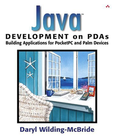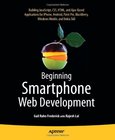Palm Programming
The Developer's Guide

Book Details:
| Publisher: | O'Reilly Media |
| Series: | OReilly , Developer's Guide |
| Author: | Neil Rhodes |
| Edition: | 1 |
| ISBN-10: | 1565925254 |
| ISBN-13: | 9781565925250 |
| Pages: | 482 |
| Published: | Dec 08 1998 |
| Posted: | Nov 19 2014 |
| Language: | English |
| Book format: | |
| Book size: | 2.07 MB |
Book Description:
PalmPilot's popularity is growing and with over a million units sold, the Palm OS dominates the hand-held market. Wired has astutely described Palm's position in a recent article: "On its way to becoming the bestselling hand-held computer of all time, the 3Com PalmPilot has spawned an intense, emotional, and fanatical developer following not seen since the glory days of the Mac." (Wired, 20 Feb. 98).Palm Programming should be eagerly accepted by programmers because the authors worked closely with Palm to ensure that the book is tailored exactly to the needs of the ever-growing group of Palm developers. As nothing but some piecemeal documentation exists currently, this book provides a much needed solution to the Palm developers. In fact, Palm uses this book as their official developer's guide and will be using it in the future as a key part of their training materials for developers.There are currently no books on Palm programming (and we know of none that are planned). The only way to learn is by using the reference material published by Palm (available freely on their Web site), the tutorial they provide, or various Palm programming FAQs compiled by third parties.Palm Programming shows intermediate to experienced C programmers how to build a Palm application from the ground up. Using an easy-to- understand tutorial approach, this book gives readers everything necessary to create a wide range of Palm applications and conduits, from simple scripts through full-blown applications, and in the process provides thorough coverage of Palm programming. It includes a CD-ROM (Macintosh and Windows compatible) with the full source code to the examples in the book, a trial version of Palm's Software Development Kit, and third-party developer tools, including Metrowerks' CodeWarrior Lite programming kit.OutlinePart 1: Overview of Palm OS and devicesChapter 1: The Palm Solution Chapter 2: Developing for Palm OS Chapter 3: Designing a solutionPart 2: Programming for the handheld Chapter 4: Structure of an Application Chapter 5: Forms and Form Objects Chapter 6: Databases Chapter 7: Menus Chapter 8: Extras Chapter 9: Communications Chapter 10: Debugging Part 3: Programming for the desktop: conduitsChapter 11: Getting started with conduits Chapter 12: Uploading and Downloading Data Chapter 13: Two-way Syncing Appendix: Where to go from here
Download Link:
Related Books:
Professional Palm OS Programming
Professional Palm OS Programming is everything programmers need to create applications for the world's most popular operating system for handheld devices.Veteran Palm developer Lonnon Foster, who has been developing commercial applications for the platform since its introduction nearly a decade ago, provides readers with hands-on instruction, lots of code, and advice that only comes from the trenches giving readers everything they need to build cutting edge applications and take advantage of the features of both Garnet and Cobalt. Coverage includes:Building forms, menus and user interfacesManaging memoryTying into Palm's standard applications such as the Calendar, Phonebook, or TasksStoring program data on removable storage cardsBuilding network ena...
Java Development on PDAs
Building Applications for Pocket PC and Palm Devices
With the release of Java 2 Micro Edition (J2ME), Sun Microsystems opened Java to the rapidly expanding Personal Digital Assistant (PDA) market. This comprehensive tutorial and reference provides an in-depth look at developing PDA software with J2ME and PersonalJava, covering both Palm and PocketPC devices. Succinct and practical, JavaaA A Development on PDAs focuses on real-world programming tasks with extensive code examples and an end-to-end PDA application demonstrating techniques for integrating devices with the enterprise via Web services. This book describes the J2ME platform and PersonalJava and discusses design issues specific to resource-constrained devices. It also provides in-depth coverage of networking and Internet access, the user inter...
Beginning Smartphone Web Development
Building JavaScript, CSS, HTML and Ajax-based Applications for iPhone, Android, Palm Pre, BlackBerry, Windows Mobile and Nokia S60
Todays Web 2.0 applications (think Facebook and Twitter) go far beyond the confines of the desktop and are widely used on mobile devices. The mobile Web has become incredibly popular given the success of the iPhone and BlackBerry, the importance of Windows Mobile, and the emergence of Palm Pre (and its webOS platform). At Apress, we are fortunate to have Gail Frederick of the well-known training site Learn the Mobile Web offer her expert advice in Beginning Smartphone Web Development. In this book, Gail teaches the web standards and fundamentals specific to smartphones and other feature-driven mobile phones and devices. Shows you how to build interactive mobile web sites using web technologies optimized for browsers in smartphones Details markup fu...
2007 - 2021 © eBooks-IT.org



